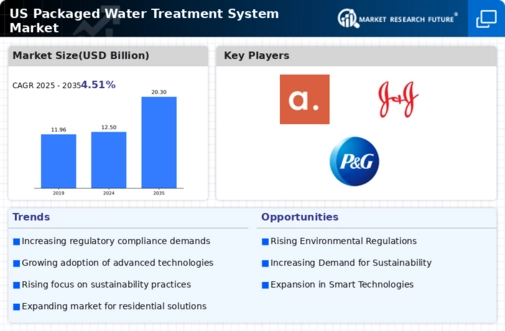Rising Environmental Concerns
Rising environmental concerns regarding water pollution and resource depletion are increasingly influencing the packaged water-treatment-system market. As awareness of environmental issues grows, consumers and businesses alike are seeking sustainable solutions to minimize their ecological footprint. Packaged water-treatment systems that utilize eco-friendly technologies and materials are becoming more appealing to environmentally conscious consumers. Furthermore, initiatives aimed at reducing plastic waste and promoting water conservation are likely to drive the adoption of these systems. The packaged water-treatment-system market may experience growth as it aligns with the broader trend of sustainability, appealing to a demographic that prioritizes environmental stewardship.
Growth in the Construction Sector
The growth in the construction sector is a vital driver for the packaged water-treatment-system market. As new residential and commercial developments emerge, the demand for integrated water treatment solutions increases. The construction of new buildings often requires compliance with local water quality regulations, which can necessitate the installation of packaged water-treatment systems. Recent data indicates that the construction industry in the US is projected to grow by approximately 5% annually, creating a favorable environment for market expansion. This trend suggests that as more properties are developed, the packaged water-treatment-system market will likely see a corresponding increase in demand, driven by the need for effective water management solutions.
Increasing Demand for Clean Water
The escalating demand for clean and safe drinking water is a primary driver for the packaged water-treatment-system market. As urbanization continues to rise, the need for efficient water treatment solutions becomes more pronounced. According to recent data, approximately 15% of the US population relies on private wells, which often lack adequate treatment. This situation creates a substantial market opportunity for packaged systems that can provide reliable purification. Furthermore, the growing awareness of waterborne diseases has led consumers to seek advanced treatment options, thereby propelling market growth. the packaged water-treatment-system market stands to gain from this increasing demand, as consumers prioritize health and safety in their water consumption choices.
Technological Advancements in Water Treatment
Technological advancements play a crucial role in shaping the packaged water-treatment-system market. Innovations such as membrane filtration, UV disinfection, and advanced oxidation processes have significantly enhanced the efficiency and effectiveness of water treatment systems. These technologies not only improve water quality but also reduce operational costs, making them attractive to both residential and commercial users. The market has witnessed a surge in the adoption of smart water treatment systems, which utilize IoT technology for real-time monitoring and management. This trend indicates a shift towards more automated and efficient solutions, further driving the packaged water-treatment-system market. As technology continues to evolve, it is likely that new solutions will emerge, catering to diverse consumer needs.
Regulatory Support for Water Quality Standards
Regulatory support for stringent water quality standards is a significant driver for the packaged water-treatment-system market. The US Environmental Protection Agency (EPA) has established guidelines that mandate the treatment of drinking water to ensure public health safety. Compliance with these regulations often necessitates the installation of advanced water treatment systems, thereby boosting market demand. Additionally, state-level initiatives aimed at improving water quality further reinforce the need for effective treatment solutions. The packaged water-treatment-system market stands to gain from these regulatory frameworks, as they compel both residential and commercial entities to invest in reliable water treatment technologies to meet compliance requirements.














Leave a Comment